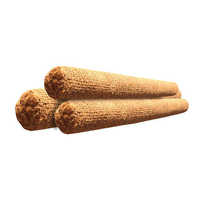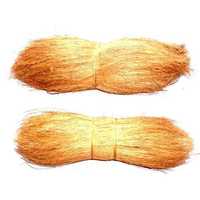Coir Fiber
(1079 products)
Explore More Categories
Light Brown 3 Tier Wax Uncut Natural
MOQ - 10 Kilograms/Kilograms
Type - 3 Tier Wax Uncut Natural
Material - Coir Fiber
Physical Form - Solid
2 Years
Business Type: Manufacturer | Distributor
FNF EXPORTS
Verified Exporter
( Accepts only Foreign Inquiry)
Eco-Friendly Brown Coir Fiber
MOQ - 100 Kilograms/Kilograms
Physical Form - Plain
Color - Light Brown
Moisture (%) - Nil
2 Years
Business Type: Manufacturer | Exporter
ROOTS AGRO EXPORTERS
Verified Exporter
( Accepts only Foreign Inquiry)
Light Brown Natural Coir Fiber
Price: 230 INR (Approx.)/Kilograms
MOQ - 100 Kilograms/Kilograms
Physical Form - Textured
Color - Light Brown
Fineness - 100%
2 Years
Business Type: Manufacturer | Supplier
EASY AGRI PEAK BUSINESS PRIVATE LIMITED
Verified Exporter
( Accepts only Foreign Inquiry)
SURYA Coir Fiber
4 Years
Business Type: Manufacturer | Exporter
SURYA EXPORTS
Verified Exporter
( Accepts only Foreign Inquiry)
Curled Coir Fibre
Price Trend: 40.00 - 120.00 INR (Approx.)/Roll
MOQ - 1 Roll/Rolls
Type - Coir Curled Fibres
Material - Curled Fibres
Color - Golden Brown, Other
5 Years
Business Type: Manufacturer | Distributor
CHANDRA PRAKASH & CO.
Light Brown Jute Fiber
Price Trend: 16.00 - 150.00 INR (Approx.)/Kilograms
MOQ - 100 Kilograms/Kilograms
Type - Jute Fiber
Material - Jute
Shape - Lose Fiber
13 Years
Business Type: Manufacturer | Distributor
CHANDRA PRAKASH & COMPANY
Raw Brown Bristle Coir Fiber Dust %: Less Than 2%
Price Trend: 280.00 - 370.00 USD ($) (Approx.)/Metric Ton
MOQ - 25 Metric Ton
Type - Fiber
Material - Coir
Physical Form - Solid
3 Years
Business Type: Exporter
SITCO INDIA
Verified Exporter
( Accepts only Foreign Inquiry)
Maitri Coir Fiber Application: Biomedical Fields
2 Years
Business Type: Manufacturer | Distributor
MAITRI ENTERPRISE
Light Brown Coir Fiber Bales With 3% Moisture And 5% Impurity Dimensions: 2*2*3 Foot (Ft)
Price Trend: 9.00 - 40.00 INR (Approx.)/Ton
MOQ - 1 Ton/Tons
Physical Form - Raw
Color - Light Brown
Dimensions - 2*2*3 Foot (ft)
6 Years
Business Type: Manufacturer | Distributor
ORGANIC HOUSE
Eco-Friendly Light Brown Coconut Coir Fiber For Multiple Industry
Price: 30 INR (Approx.)/Kilograms
MOQ - 100 Kilograms/Kilograms
Material - Coconut Coir
Physical Form - Plain
Color - Light Brown
2 Years
Business Type: Manufacturer | Distributor
SHANTHI COIR PRODUCTS
Coconut Coir Fiber
Business Type: Manufacturer | Distributor
VANTAGE RESOURCES LTD.
Coco Coir Fibre
Business Type: Manufacturer | Supplier
YAHAYA TRADERS
Coconut Fiber
Business Type: Manufacturer
Raja Agro Industries
Indian Inquiries Only
IYAPPAN Coir Fiber
Business Type: Manufacturer | Supplier
BLESSING EXPORTS
Eco Friendly Natural Coconut Coir Log
MOQ - 100 Unit/Units
Type - Coconut Coir Log
Material - Coconut Fiber
Physical Form - Plain
Business Type: Manufacturer
Spider Coir Industry
GEEWIN Coir Fiber
Business Type: Manufacturer | Supplier
GEEWIN EXIM
Verified Exporter
( Accepts only Foreign Inquiry)
GLOBAL Coir Fiber
Business Type: Manufacturer | Distributor
GLOBAL FOAM & FURNISHINGS
Coconut Fiber
Business Type: Manufacturer | Supplier
KRISHNA COIRS PVT. LTD.
Indian Inquiries Only
Golden Brown Predrilled Coir Logs
Price Trend: 300.00 - 1200.00 INR (Approx.)/Piece
MOQ - 300 Piece/Pieces
Product Type - Coir Log
Material - Coconut Fiber
Attributes - Eco-Friendly
Business Type: Manufacturer | Distributor
Jayasree Coir Mills
Coir Logs
Business Type: Manufacturer | Trading Company
ST.GEORGE COIR MILLS
VIGNESHWARA Coir Fiber
Business Type: Manufacturer | Supplier
VIGNESHWARA EXPORT
Verified Exporter
( Accepts only Foreign Inquiry)
Light Brown Long Lasting Coir Geo
Price: 4000 INR (Approx.)/Roll
MOQ - 10 Roll/Rolls
Type - Long Lasting Coir Geo
Material - Coir
Physical Form - Solid
Business Type: Manufacturer | Trading Company
Jaya Coir Works
Coir Fibre
Business Type: Manufacturer | Supplier
SKT TEXTILE SERVICE INDIA PRIVATE LIMITED
Indian Inquiries Only
SRI MKS Coir Fiber
Business Type: Manufacturer | Distributor
shri amrita medical agency
Dark Brown Coco Bristle Fiber (Coir)
MOQ - 100 Piece/Pieces
Color - Dark Brown
Feature - Eco-Friendly
Business Type: Trading Company
Wushu Store
Eco-Friendly Natural Coir Fiber
Feature - Eco-Friendly, Flame Retardant, Anti-Bacteria
Business Type: Supplier | Exporter
I-MAM EXIM
Verified Exporter
( Accepts only Foreign Inquiry)
Light Brown Round Coco Coir Logs
MOQ - 10000 Ton/Tons
Type - Coco Coir Logs
Physical Form - Solid
Shape - Cylindrical
Business Type: Manufacturer | Supplier
MAHENDRA EXPORTS AND IMPORTS
Coir Fiber 35kg Blocks
Response Rate: 100.00%
Business Type: Manufacturer | Distributor
Pyramid Cocopeat
Coir Fiber Manufacturers | Suppliers in India
| Company Name | Location | Member Since |
|---|---|---|
| Chandra Prakash & Company | Jaipur, India | 13 Years |
| Organic House | Vadodara, India | 6 Years |
| Chandra Prakash & Co. | Kolkata, India | 5 Years |
| Surya Exports | Tirunelveli, India | 4 Years |
| Sitco India | Bengaluru, India | 3 Years |
| Fnf Exports | Colombo, Sri Lanka | 2 Years |
| Roots Agro Exporters | Pollachi, India | 2 Years |
| Easy Agri Peak Business Private Limited | Pollachi, India | 2 Years |
| Maitri Enterprise | Junagadh, India | 2 Years |
| Shanthi Coir Products | Nagercoil, India | 2 Years |
What is Coir Fiber?
Types of Coir fiber
Applications & Usage of Coir Fiber
Advantages of Coir Fiber
FAQs: Coir Fiber
Related Categories
Agricultural Machines & Tools
Agriculture & By-product Agents
Agriculture Product Stocks
Agro Chemicals
Agro Products & Commodities
Animal Casings
Animal Extract
Animal Fodders
Animal Husbandry
Animal Products
Aquaculture Equipment & Supplies
Aquatic Products
Bactericides
Bamboo & Rattan Products
Beans
Cashews
Cattle Feed Supplements
Cereals
Coconut
Coconut Shell Products
Coffee
Coir Blocks
Coir Fiber
Coir Products
Coir Rope
Dehydrated Vegetables
Dried Vegetables
EMU & EMU Products
EMU Eggs
EMU Meat
EMU Oil Products
Eggs
Farm Machinery
Farm Machinery Parts
Fertilizers
Fodder & Feed Additives
Fresh Fruits
Fresh Vegetables
Frozen & Dried Fruit
Frozen Vegetables
Fungicides
Garden Accessories
Grain
Greenhouse Supplies & Equipment
Guar Gum
Herbicides
Horticulture & Gardening Tools
Horticulture, Gardening & Irrigation Machinery
Insecticides
Irrigation Systems
Jute Products
Livestock
Molasses
Mushroom & Truffle
Nematicides
Nuts & Kernels
Oil Seed Extraction Machinery
Organic Vegetables
Pesticides
Plant & Animal Oil
Plant Extract
Plant Growth Regulator
Plant Seeds
Plant, Flowers & Dried Flowers
Potpourri
Poultry Equipment
Poultry Feed Supplements
Pulses
Raw Cotton & Cotton Waste
Rice
Seed Processing Machinery
Seeds
Shade Net
Soil Conditioners
Storage Silos
Tea
Tractor Parts
Tractors
Wheat

